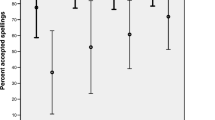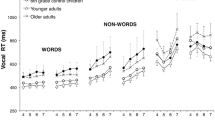Abstract
The present experiment represents an attempt to learn from the comparison of dyslectic readers, prelingually deafened readers, and a control group of typically developing hearing readers, in four particular areas, about factors determining their reading skills.Twenty-three students with diagnosed dyslexia (mean grade level 9.7 [1.53]), 20 students with prelingual deafness (mean grade level 8.9 [1.33]), and a control of 41 typically developing hearing students (mean grade level 8.9 [1.43]) participated in the study.Four distinct areas were examined which included: (a) the rapid, repetitive execution of two simple, familiar motor actions; (b) the rapid, consecutive judgment of the identicalness of two digit stimuli; (c) the rapid, consecutive, perceptual processing of word pairs; and (d) the rapid, consecutive, conceptual processing of word pairs. Findings obtained from th comparison of the three participant groups in the four tested areas indicate that the reading difficulties of dyslectic readers and prelingually deafened readers have differentsources, neither of which are directly, causally related to a phonological processing deficit.
Similar content being viewed by others
References
American National Standards Institute (1989). Specifications for Audiometers, (ANSI S3.6-1989), ANSI, New York.
Baddeley, A. D. (1986). Working Memory, Clarendon Press, Oxford.
Baddeley, A. D. (1990). Human Memory: Theory and Practice. Erlbaum, Hillsdale, USA.
Bigsby, P. (1986). The nature of reversible letter confusions in dyslectic and normal readers: Misinterpretation or mislabeling? Br. J. Educ. Psychol. 55: 264–272.
Breznitz, Z. (2001). The determinants of reading fluency: A comparison of dyslectic and average readers. In Wolf, M. (ed.), Dyslexia, Fluency and the Brain, York Press, Timonium, Maryland, pp. 245–276.
Byrne, B., and Fielding-Barnsley, R. (1989). Phonemic awareness and letter knowledge in the child's acquisition of the alphabetic principle. J. Educ. Psychol. 81(3): 313–321.
Chapman, J. W., and Tunmer, W. E. (2003). Reading difficulties, reading-related self-perceptions, and strategies for overcoming negative self-beliefs. Read. Writ. Q.: Overcoming Learn. Difficulties 19(1): 5–24.
Charlier, B. L., and Leybaert, J. (2000). The rhyming skills of deaf children educated with phonetically augmented speech reading. Q. J. Exp. Psychol. 53: 349–375.
Conrad, R. (1979). The Deaf School Child, Harper and Row, London.
Damian, M. F. (2004). Asymmetries in the processing of Arabic digits and number words. Memory Cognit. 32: 164–171.
Dyer, A., MacSweeney, M., Szczerbinski, M., and Campbell, R. (2003). Predictors of reading delay in deaf adolescents: The relative contributions of rapid automatized naming speed and phonemic awareness and decoding. J. Deaf Stud. Deaf Educ. 8: 215–229.
Ehri, L. C., Nunes, S. R., Stahl, S. A., and Willows, D. M. (2001). Systematic phonics instruction helps students learn to read: Evidence from the National Reading Panel's meta-analysis. Rev. Educ. Res. 71(3): 393–447.
Fias, W., Reynvoet, B., and Brysbeart, M. (2001). Are Arabic numerals processed as pictures in a Stroop interference task? Psychologic. Res. 65: 242–249.
Frost, R. (1998). Toward a strong phonological theory of visual word recognition: True issues and false trials. Psychologic. Bull. 123: 71–99.
Hanson, V. L. (1989). Phonology in reading: Evidence from profoundly deaf readers. In Shankweiler, D., and Libermann, I. Y. (eds.), Phonology and Reading Disabilities: Solving the Reading Puzzle, University of Michigan Press, Research Monograph Series. Ann Arbor, pp. 66–90.
Hanson, V. L. (1991). Phonological processing without sounds. In Brady, S., and Shankweiler, D. (eds.), Phonological Processes in Literacy: A Tribute to Isabelle Y. Liberman, Erlbaum, Hillsdale, NJ, pp. 153–161.
Hanson, V. L., and Fowler, C. A. (1987). Phonological coding in word reading: Evidence from hearing and deaf readers. Memory Cognit. 15: 199–207.
Hanson, V. L., Liberman, I. Y., and Shankweiler, D. (1984). Linguistic coding in deaf children in relation to beginning reading success. J. Exp. Child Psychol. 37: 378–393.
Hanson, V. L., and Lichtenstein, E. H. (1990). Short-term memory coding by deaf signers: The primary language coding hypothesis reconsidered. Cognit. Psychol. 22: 211–224.
Hanson, V. L., and McGarr, N. S. (1989). Rhyme generation by deaf adults. J. Speech Hear. Res. 32: 2–11.
Harris, M., and Moreno, C. (2004). Deaf children's use of phonological coding: Evidence from reading, spelling, and working memory. J. Deaf Stud. Deaf Educ. 9: 253–268.
Izzo, A. (2002). Phonemic awareness and reading ability: An investigation with young readers who are deaf. Am. Ann. Deaf 147: 18–29.
Kjeldsen, A. C., Niemi, P., and Olofsson, A. (2003). Training phonological awareness in kindergarten level children: Consistency is more important than quality. Learn. Instruct. 13: 349–365.
Krause, W., Schack, B., Gibbons, H., and Kreise, B. (1997). On the distinguishability of conceptual and imaginal representations in elementary thinking. Zeitschrift Psychol. 205: 169–203.
Lillo-Martin, D., Hanson, V., and Smith, S. (1992). Deaf readers' comprehension of relative clauses. Appl. Psycholinguist. 13: 13–30.
Miller, P. (1997). The effect of communication mode on the development of phonemic awareness in prelingually deaf students. J. Speech Hear. Res. 40: 1151–1163.
Miller, P. (2000). Syntactic and semantic processing in deaf and hearing readers. Am. Ann. Deaf 145: 436–448.
Miller, P. (2002). Another look at the STM capacity of prelingually deafened individuals and its relation to reading comprehension. Am. Ann. Deaf 147: 56–70.
Miller, P. (2004a). Processing of written words by individuals with prelingual deafness. J. Speech Lang. Hear. Res. 47: 979–989.
Miller, P. (2004b). Processing of written word and non-word visual information by individuals with prelingual deafness. J. Speech Lang. Hear. Res. 47: 990–1000.
Miller, P. (2004c). The word decoding strategies of Hebrew readers with and without hearing impairments: Some insight from an associative learning task. Read. Writ. Special Issue 17: 823–845.
Miller, P. (in press). What the word recognition skills of prelingually deafened readers tell about their reading comprehension problems. J. Dev. Phys. Disabil.
Musselman, C. (2000). How do children who can't hear learn to read an alphabetic script? A review of the literature on reading and deafness. J. Deaf Stud. Deaf Educ. 5: 11–31.
Neubauer, A. C., Riemann, R., Mayer, R., and Angleitner, A. (1997). Intelligence and reaction times in the Hick, Sternberg and Posner paradigms. Pers. Ind. Diff. 22: 885–894.
Nielsen, D. C., and Leutke-Stahlman, B. (2002). Phonological awareness: One key to the reading proficiency of deaf children. Am. Ann. Deaf 147: 11–19.
Padden, C. A., and Hanson, V. (2000). Search for the missing link: The development of skilled reading in deaf children. In Emmorey, K., and Lane, H. (eds.), The signs of language revised: An anthology to honor Ursula Bellugi and Edward Klima, Erlbaum, Mahwah, NJ, pp. 435–447.
Paul, P. (2001). Language and Deafness (3rd edn.), Singular Publishing Group, San Diego, CA.
Perfetti, C. A., and Sandak, R. (2000). Reading optimally builds on spoken language: Implications for deaf readers. J. Deaf Stud. Deaf Educ. 5: 32–50.
Report of the National Reading Panel (2000). Teaching Children to Read: An Evidence-Based Assessment of the Scientific Research Literature on Reading and Its Implications for Reading Instruction (NIH Publication No. 00-4769), U.S. Government Printing Office, Washington, DC.
Share, D. L. (1995). Phonological recoding and self-teaching: Sine qua non of reading acquisition. Cognition 55(2): 151–218
Share, D. L. (1999). Phonological recoding and orthographic learning: A direct test of the self-teaching hypothesis. J. Exp. Child Psychol. 72: 95–129.
Share, D. L., and Levin, I. (1999). Learning to read and write in Hebrew. In Harris, M., and Hatano, G. (eds.), Learning to Read and Write, Cambridge University Press, Cambridge, pp. 89–111.
Sutcliffe, A., Dowker, A., and Campbell, R. (1999). Deaf children's spelling: Does it show sensitivity to phonology? J. Deaf Stud. Deaf Educ. 4: 111–123.
Snow, C. E., Burns, M. S., and Griffin, P. (1998). Preventing Reading Difficulties in Young Children, National Academic Press, Washington, DC.
Stanovich, K. E., and Siegel, L. S. (1994). Phenotypic performance profile of children with reading disabilities: A regression-based test of the phonological-core difference model. J. Educ. Psychol. 86: 24–53.
Transler, C., Leybaert, J., and Gomert, J. E. (1999). Do deaf children use phonological syllables as reading units? J. Deaf Stud. Deaf Educ. 4: 124–143.
Vellutino, F. R., Fletcher, J. M., Snowling, M. J., and Scanlon, D. M. (2004). Specific reading disability (dyslexia): What have we learned over the past four decades? J. Child Psychol. Psychiatr. 45: 2–40.
Author information
Authors and Affiliations
Corresponding author
Rights and permissions
About this article
Cite this article
Miller, P. What the Word Processing Skills of Prelingually Deafened Readers Tell About the Roots of Dyslexia. J Dev Phys Disabil 17, 369–393 (2005). https://doi.org/10.1007/s10882-005-6620-9
Issue Date:
DOI: https://doi.org/10.1007/s10882-005-6620-9




